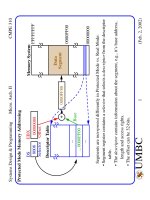Thiết kế và lập trình hệ thống - Chương 28
Bạn đang xem bản rút gọn của tài liệu. Xem và tải ngay bản đầy đủ của tài liệu tại đây (282.38 KB, 14 trang )
Systems Programming Linux Device Drivers II CMPE 310
1 (April 25, 2000 11:07 pm)
UMBC
U M B C
U
N
I
V
E
R
S
I
T
Y
O
F
M
A
R
Y
L
A
N
D
B
A
L
T
I
M
O
R
E
C
O
U
N
T
Y
1
9
6
6
The Kernel Symbol Table
insmod resolves undefined symbols against the kernel’s public symbols.
These include both functions and variables.
The symbol table lives in /proc/ksyms.
Global symbols in your module are added here.
Use ksyms to output them directly.
Module loading order can be important, particularly if they are stacked
(dependent on the symbols defined in other modules).
The parallel port subsystem is composed of a set of stacked modules:
lp
parport
parport_pc
Kernel
API
Message
printing,
driver reg,
port alloc,
etc.
lower
level
Systems Programming Linux Device Drivers II CMPE 310
2 (April 25, 2000 11:07 pm)
UMBC
U M B C
U
N
I
V
E
R
S
I
T
Y
O
F
M
A
R
Y
L
A
N
D
B
A
L
T
I
M
O
R
E
C
O
U
N
T
Y
1
9
6
6
The Kernel Symbol Table
Layered modularization can simplify development.
Lower layers export symbols for use in higher level modules.
Kernel header fi les provide a convenient way to manage the visibility of your
symbols (you usually don’t want all non-static symbols exported).
If no symbols are to be exported, add to init_module the line:
EXPORT_NO_SYMBOLS;
To export a subset of your symbols, add the following line before includ-
ing module.h
#define EXPORT_SYMTAB
or defi ne it using the -D compiler flag in the makefi le.
If EXPORT_SYMTAB is defi ned, then outside any function add:
EXPORT_SYMBOL(name); /* or */
EXPORT_SYMBOL_NOVERS(name); /* no version info */
The symbol name is exported.
Systems Programming Linux Device Drivers II CMPE 310
3 (April 25, 2000 11:07 pm)
UMBC
U M B C
U
N
I
V
E
R
S
I
T
Y
O
F
M
A
R
Y
L
A
N
D
B
A
L
T
I
M
O
R
E
C
O
U
N
T
Y
1
9
6
6
Initialization and Shutdown
init_module registers any facility offered by the module.
This is performed by passing several arguments to a kernel function:
• A pointer to a data structure, which embeds pointers to module functions.
• The name of the facility being added.
If any errors occur during registration, e.g., out of memory, you must undo
any registration performed before the error.
Otherwise, the kernel is left in an unstable state.
int init_module(void)
{
int err; /* Errors defined in <linux/errno.h> */
err = register_this(ptr1, “skull”);
if (err) goto fail_this;
...
return 0;
...
fail_this(unregister_this(ptr1), “skull”);
return err;}
Systems Programming Linux Device Drivers II CMPE 310
4 (April 25, 2000 11:07 pm)
UMBC
U M B C
U
N
I
V
E
R
S
I
T
Y
O
F
M
A
R
Y
L
A
N
D
B
A
L
T
I
M
O
R
E
C
O
U
N
T
Y
1
9
6
6
Initialization and Shutdown
The cleanup module also calls these unregister functions:
void cleanup_module(void)
{
...
unregister_this(ptr1, “skull”);
return;
}
Usage Counts:
The system keeps usage counts on modules to determine if a module can
be safely removed.
A module cannot be removed if it is “busy”.
Macros, such as MOD_INC_USE_COUNT, are used to increment, decre-
ment and check the status.
It is easy to lose track of the count during debug (e.g. a process gets
destroyed because your driver references a NULL pointer).
Setting these macros to no-ops is useful in this case.
Systems Programming Linux Device Drivers II CMPE 310
5 (April 25, 2000 11:07 pm)
UMBC
U M B C
U
N
I
V
E
R
S
I
T
Y
O
F
M
A
R
Y
L
A
N
D
B
A
L
T
I
M
O
R
E
C
O
U
N
T
Y
1
9
6
6
Initialization and Shutdown
Usage Counts:
The fi le /proc/modules gives a list of the currently loaded modules.
Some of mine are given below:
ide-cd 26848 0 (autoclean)
cdrom 27232 0 (autoclean) [ide-cd]
autofs 11264 1 (autoclean)
The fi rst fi eld is the name of the module
The second is the number of bytes in use.
The third fi eld gives the usage count.
The forth fi eld (kernels >2.1.18) lists optional flags
The fi fth fi eld (kernels >2.1.18) lists modules that reference this module.
rmmod calls cleanup_module only if the usage count is zero.
As shown above, cleanup_module unregisters facilities explicitly while
the symbol table is removed automatically.
Names other than init_module and cleanup_module can be used now via the
functions module_init(my_init) and module_exit(my_cleanup) in <linux/init.h>









